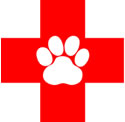An echocardiogram is an ultrasound of the heart. It allows us to evaluate the heart, including wall thickness, chamber size, valve function, blood flow and contractility.
The heart is a muscular organ in the chest. It functions as a mechanical pump and moves blood through the vessels in the body. The heart has two sides, a right side and a left side. Each side has an upper chamber (atrium) and a lower chamber (ventricle).
Oxygen-poor blood from the body enters the heart at the right atrium, which contracts and moves blood through the tricuspid valve into the right ventricle. The contraction of the right ventricle now pumps blood into the lungs. In the lungs this blood is replenished with oxygen.
The oxygenated blood then returns to the left side of the heart. It first enters the left atrium. From here the blood is forced through the mitral valve and into the left ventricle. The left ventricle then contracts and pumps blood into the aorta, delivering oxygen-rich blood to the body.
Echocardiography is a non-invasive and low-stress diagnostic test performed with your pet lying on a padded table. To get better contact between the ultrasound probe and the skin, we will recommend clipping a little area around the axillary region. If you would prefer not to have your pet clipped, please let us know in advance and we will try to accommodate your wishes.
In most cases no sedation (tranquilizers) is necessary. However, some of our patients will be more relaxed if sedation is used, so we may ask for your permission to do so if we feel it is in the best interest of your pet.
This test is essential in diagnosing most heart diseases, including disease affecting the heart valves (chronic degenerative valve disease), thickening of the heart muscle (hypertrophic cardiomyopathy), dilation of the heart (dilated cardiomyopathy), congenital heart diseases (patent ductus arteriosus, pulmonic stenosis, subaortic stenosis), or tumors of the heart.
The electrocardiogram (also known as ECG or EKG) is a non-invasive test evaluating the electrical activity of the heart. It is performed with your pet lying on its right side with electrodes attached to its skin. The EKG will help detect abnormal heart rates and rhythms (arrhythmias), and it will also provide information regarding chamber enlargement and abnormal conduction.
In a normal heart the heartbeat is initiated by the sinus node. The sinus node is a pacemaker region located high in the right atrium. The electrical impulse generated by the sinus node travels through the atria, which then contracts. The impulse then passes through specialized cardiac conduction tissue, which rapidly distributes the electrical impulse to the left and right ventricles. The ventricles then contract, and blood is forced to the body and lungs. This pattern of electrical impulse production and conduction is repeated for every beat. If at any point the normal conduction is disturbed, it will lead to an abnormal EKG and allow us to diagnose your pet’s arrhythmia.
A Holter monitor is a small, wearable device fitted to your pet that records the heart’s electrical rhythm for a 24-hour period. It provides us with a heart rate and rhythm over a much longer period of time than an EKG performed in the hospital. It also helps us determine the heart rate and rhythm in the home environment, rather than in the veterinary hospital, where stress and excitement may confound our interpretation.
You will be instructed to take notes on a Holter diary. This important information helps us interpret whether the heart rate we are seeing is appropriate or inappropriate (sleep versus activity). After 24 hours you may remove the Holter and drop it off at the Veterinary Health Center. If you don’t feel comfortable removing the Holter yourself, one of our VHC members will be happy to give you a hand.
Radiographs (also called X-rays) of the chest allow us to assess the heart, lungs and adjacent structures. They help us diagnose your pet’s heart disease and severity. A radiograph is the test of choice to diagnose left-sided congestive heart failure (fluid within the lung tissue) and will also show if fluid is present in the chest cavity. This test takes only minutes and usually can be performed without any sedation and using only gentle restraint.
There are a variety of heart diseases that lead to an increase in certain markers found in the bloodstream (NT-proBNP, Troponin I). Besides these heart-specific markers, blood and urine tests give us a lot of valuable information about your pet’s blood cells, organ function and electrolyte balance. This is not only crucial in order to monitor your pet while on heart failure medication. A lot of our patients are older pets, and comorbidities (having two or more disorders or diseases at the same time), which are much more common in that population, may need to be addressed as well.



